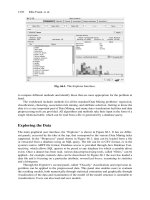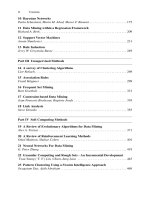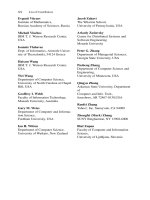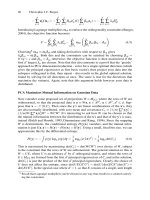Data Mining and Knowledge Discovery Handbook, 2 Edition part 85 docx
Bạn đang xem bản rút gọn của tài liệu. Xem và tải ngay bản đầy đủ của tài liệu tại đây (498.21 KB, 10 trang )
820 Moty Ben-Dov and Ronen Feldman
The above are examples of the researches which has been done to implement the
HMM for IE tasks. The results we get for IE by using the HMM are good comparing
to other techniques but there are few problems in using HMM.
The main disadvantage of using an HMM for Information extraction is the need
for a large amount of training data the more training data we have the better results
we get. To build such training data it a time consuming task. We need to do lot of
manually tagging which must to be done by experts of the specific domain we are
working with.
The second one is that the HMM model is a flat model, so the most it can do
is assign a tag to each token in a sentence. This is suitable for the tasks where the
tagged sequences do not nest and where there are no explicit relations between the
sequences. Part-of-speech tagging and entity extraction belong to this category, and
indeed the HMM-based PoS taggers and entity extractors are state-of-the-art. Ex-
tracting relationships is different, because the tagged sequences can (and must) nest,
and there are relations between them which must be explicitly recognized.
Stochastic Context-Free Grammars
A stochastic context-free grammar (SCFG) (Lari and Young, 1990; Collins, 1996;
Kammeyer and Belew, 1996; Keller and Lutz, 1997a; Keller and Lutz, 1997b; Os-
borne and Briscoe, 1998) is a quintuple G = (T,N,S,R,P), where T is the alphabet
of terminal symbols (tokens), N is the set of nonterminals, S is the starting nonter-
minal, R is the set of rules, and P : R → [0 1] defines their probabilities. The rules
have the form n → s
1
s
2
s
k
, where n is a nonterminal and each s
i
either token or
another nonterminal. As can be seen, SCFG is a usual context-free grammar with the
addition of the P function.
Similarly to a canonical (non-stochastic) grammar, SCFG is said to generate (or
accept) a given string (sequence of tokens) if the string can be produced starting
from a sequence containing just the starting symbol S, and one by one expanding
nonterminals in the sequence using the rules from the grammar. The particular way
the string was generated can be naturally represented by a parse tree with the starting
symbol as a root, nonterminals as internal nodes and the tokens as leaves.
The semantics of the probability function P is straightforward. If r is the rule
n → s
1
s
2
s
k
, then P(r) is the frequency of expanding n using this rule. Or, in
Bayesian terms, if it is known that a given sequence of tokens was generated by
expanding n, then P(r) is the apriori likelihood that n was expanded using the rule
r. Thus, it follows that for every nonterminal n the sum
∑
P(r) of probabilities of all
rules r headed by n must equal to one.
Maximal Entropy Modelling
Consider a random process of an unknown nature which produces a single output
value y, a member of a finite set Y of possible output values. The process of gener-
ating y may be influenced by some contextual information x, a member of the set X
42 Text Mining and Information Extraction 821
of possible contexts. The task is to construct a statistical model that accurately rep-
resents the behavior of the random process. Such a model is a method of estimating
the conditional probability of generating y given the context x.
Let P(x,y) be denoted as the unknown true joint probability distribution of the
random process, and p(y|x) the model we are trying to build, taken from the class
℘
of all possible models. In order to build the model we are given a set of training
samples, generated by observing the random process for some time. The training
data consists of a sequence of pairs (x
i
,y
i
) of different outputs produced in different
contexts.
In many interesting cases the set X is too large and underspecified to be directly
used. For instance, X may be the set of all dots “.” in all possible English texts. For
contrast, the Y may be extremely simple, while remaining interesting. In the above
case, the Y may contain just two outcomes: “SentenceEnd” and “NotSentenceEnd”.
The target model p(y|x) would in this case solve the problem of finding sentence
boundaries.
In cases like that it is impossible to directly use the context x to generate the
output y. However, there are usually many regularities and correlations, which can
be exploited. Different contexts are usually similar to each other in all manner of
ways, and similar contexts tend to produce similar output distributions (Berger et al.,
1996; Ratnaparkhim, 1996; Rosenfeld, 1997; McCallum et al., 2000; Hopkins and
Cui, 2004).
42.6 Hybrid Approaches - TEG
The knowledge engineering (mostly rule based) systems traditionally were the top
performers in most IE benchmarks, such as MUC (Chinchor et al., 1994), ACE
(ACE, 2002) and the KDD CUP (Yeh et al., 2002). Recently though, the machine
learning systems became state-of-the-art, especially for simpler tagging problems,
such as named entity recognition (Bikel, et al., 1999; Chieu and Ng, 2002), or field
extraction (McCallum et al., 2000).
Still, the knowledge engineering approach retains some of its advantages. It is
focused around manually writing patterns to extract the entities and relations. The
patterns are naturally accessible to human understanding, and can be improved in
a controllable way. Whereas, improving the results of a pure machine learning sys-
tem, would require providing it with additional training data. However, the impact of
adding more data soon becomes infinitesimal while the cost of manually annotating
the data grows linearly.
TEG (Rosenfeld et al., 2004) is a hybrid entities and relations extraction system,
which combines the power of knowledge-based and statistical machine learning ap-
proaches. The system is based upon SCFGs. The rules for the extraction grammar
are written manually, while the probabilities are trained from an annotated corpus.
The powerful disambiguation ability of PCFGs allows the knowledge engineer to
write very simple and naive rules while retaining their power, thus greatly reducing
the required labor.
822 Moty Ben-Dov and Ronen Feldman
In addition, the size of the needed training data is considerably smaller than the
size of the training data needed for pure machine learning system (for achieving
comparable accuracy results). Furthermore, the tasks of rule writing and corpus an-
notation can be balanced against each other.
Although the formalisms based upon probabilistic finite-state automata are quite
successful for entity extraction, they have shortcomings, which make them harder to
use for the more difficult task of extracting relationships.
One problem is that a finite-state automaton model is flat, so its natural task is
assignment of a tag (state label) to each token in a sequence. This is suitable for
the tasks where the tagged sequences do not nest and where there are no explicit
relations between the sequences. Part-of-speech tagging and entity extraction tasks
belong to this category, and indeed the HMM-based PoS taggers and entity extractors
are state-of-the-art.
Extracting relationships is different in that the tagged sequences can and must
nest, and there are relations between them, which must be explicitly recognized.
While it is possible to use nested automata to cope with this problem, we felt that
using more general context-free grammar formalism would allow for a greater gen-
erality and extendibility without incurring any significant performance loss.
42.7 Text Mining – Visualization and Analytics
One of the crucial needs in text mining process is the ability enables the user to vi-
sualize relationships between entities that were extracted from the documents. This
type of interactive exploration enables one to identify new types of entities and re-
lationships that can be extracted and, better explore the results of the information
extraction phase. There are tools that can do the analytic and visualization task, the
first is Clear Research (Aumann et al., 1999; Feldmanet al., 2001; Feldman et al.,
2002).
42.7.1 Clear Research
Clear Research has five different visualization tools to analyze the entities and rela-
tionships. The following subsections present each one of them.
Category Connection Map
Category Connection Maps provide a means for concise visual representation of
connections between different categories, e.g. between companies and technologies,
countries and people, or drugs and diseases. The system finds all the connections
between the terms in the different categories. To visualize the output, all the terms in
the chosen categories are depicted on a circle, with each category placed on a sepa-
rate part on the circle. A line is depicted between terms of different categories which
are related. A color coding scheme represents stronger links with darker colors. An
42 Text Mining and Information Extraction 823
example of a Category Connection Map is presented in Figure 42.4. In this chap-
ter we used a text collection (1354 documents) from yahoo-news about Bin Laden
organization. In Figure 42.4 we can see the connection between Persons and Organi-
zations.
Fig. 42.4. Category map – connections between Persons and Organizations
Relationship Maps
Relationship maps provide a visual means for concise representation of the relation-
ship between many terms in a given context. In order to define a relationship map the
user defines:
• A taxonomy category (e.g. “companies”), which determines the nodes of the
circle graph (e.g. companies)
• An optional context node (e.g. “joint venture”): which will determine the type of
connection we wish to find among the graph nodes.
In Figure 42.5 we can see an example of relations map between Persons. The graph
gives the user a summary of the entire collection in one view. The user can appreciate
the overall structure of the connections between persons in this context, even before
reading a single document!
824 Moty Ben-Dov and Ronen Feldman
Fig. 42.5. Relationship map– relations between Persons
Spring Graph
A spring graph is a 2D graph where the distance between 2 elements should reflect
the strength of the relationships between the elements. The stronger the relationship
the closer the two elements should be. An example of a spring graph is shown in
Figure 42.6. The graph represents the relationships between the people in a document
collection. We can see that Osama Bin Laden is at the center connected to many of
the other key players related to the tragic events.
Link Analysis
This query enables users to find interesting but previously unknown implicit infor-
mation within the data. The Links Analysis query automatically organizes links (as-
sociations) between entities that are not present in individual documents. The results
of a link analysis query can give new insight into the data and interprets the relevant
interconnections between entities.
The Links Analysis query results graphically illustrate the links that indicate the
associations among the selected entities. The results screen arranges the source and
42 Text Mining and Information Extraction 825
Fig. 42.6. Spring Graph
destination nodes at opposite ends and places the connecting nodes between them
enabling users to follow the path that links the nodes together. The Links Analysis
query is useful to users that require a graphical analysis that charts the interconnec-
tions among entities through implicit channels.
The Link Analysis query implicitly illustrates inter-relationships between enti-
ties. Users define the query criterion by defining the: source, destination and con-
nection through entities. In this manner - the results, if any relations are found, will
display the defined entities and the paths that show how they connect to one another,
e.g. through third party or more entities.
In Figure 42.7 we can see a link analysis query about relation between Osama
Bin Laden and John Paul II. We can see that there is no direct connection between
the two but we can find indirect connection between them.
For more information regarding Link Analysis please refer to Chapter 17.5 in
this volume.
826 Moty Ben-Dov and Ronen Feldman
Fig. 42.7. Link Analysis – relations between Bin Laden and John Paul II.
42.7.2 Other Visualization and Analytical Approaches
The BioTeKS is an IBM prototype system for text analysis, search, and text-mining
methods to support problem solving in life science, which was build by several
groups in the IBM Research Division. The system is called “BioTeKS” (“Biological
Text Knowledge Services”), and it integrates research technologies from multiple
IBM Research labs (Mack et al., 2004)
The SPIRE text visualization system, which images information from free text
documents as natural terrains, serves as an example of the “ecological approach” in
its visual metaphor, its text analysis, and its specializing procedures (Wise, 1999).
The ThemeRiver visualization depicts thematic variations over time within a
large collection of documents. The thematic changes are shown in the context of a
time line and corresponding external events. The focus on temporal thematic change
within a context framework allows a user to discern patterns that suggest relation-
ships or trends. For example, the sudden change of thematic strength following an
external event may indicate a causal relationship. Such patterns are not readily ac-
cessible in other visualizations of the data (Havre et al., 2002).
An approach for visualization technique of association rules is described in the
following article (Wong et al., 1999). We can find a technique for visualizing Se-
quential Patterns was describe in the work done by the Pacific Northwest National
Laboratory (Wong et al., 2000).
42 Text Mining and Information Extraction 827
References
ACE (2002). ACE - Automatic Content Extrac-
tion.
Aizawa, A. (2001). Linguistic Techniques to Improve the Performance of Automatic Text
Categorization. Proceedings of NLPRS-01, 6th Natural Language Processing Pacific
Rim Symposium. Tokyo, JP: 307-314.
Al-Kofahi, K., A. Tyrrell, A., Vachher, A., Travers, T., and Jackson (2001). Combining Mul-
tiple Classifiers for Text Categorization. Proceedings of CIKM-01, 10th ACM Interna-
tional Conference on Information and Knowledge Management. H. P. a. L. L. a. D.
Grossman. Atlanta, US, ACM Press, New York, US: 97-104.
Apte, C., Damerau, F. J., and Weiss, S. M. (1994). Automated learning of decision rules for
text categorization. ACM Transactions on Information Systems, 12(3): 233-251.
Attardi, G., Gulli, A., and Sebastiani, F. (1999). Automatic Web Page Categorization by
Link and Context Analysis. In C. H. a. G. Lanzarone (Ed.), Proceedings of THAI-99, 1st
European Symposium on Telematics, Hypermedia and Artificial Intelligence: 105-119.
Varese,
Attardi, G., Marco, S. D., and Salvi, D. (1998). Categorization by context. Journal of Uni-
versal Computer Science, 4(9): 719-736.
Aumann Y., Feldman R., Ben Yehuda Y., Landau D., Lipshtat O., and Y, S. (1999). Circle
Graphs: New Visualization Tools for Text-Mining. Paper presented at the PKDD.
Averbuch, M., Karson, T., Ben-Ami, B., Maimon, O., and Rokach, L. (2004). Context-
sensitive medical information retrieval, MEDINFO-2004, San Francisco, CA, Septem-
ber. IOS Press, pp. 282-262.
Bao, Y., Aoyama, S., Du, X., Yamada, K., and Ishii, N. (2001). A Rough Set-Based Hybrid
Method to Text Categorization. In M. T. O. a. H J. S. a. K. T. a. Y. Z. a. Y. Kambayashi
(Ed.), Proceedings of WISE-01, 2nd International Conference on Web Information Sys-
tems Engineering: 254-261. Kyoto, JP: IEEE Computer Society Press, Los Alamitos,
US.
Baeza-Yates, R. and Ribeiro-Neto, B. (1999). Modern Information Retrieval, Addison-
Wesley.
Benkhalifa, M., Mouradi, A., and Bouyakhf, H. (2001a). Integrating External Knowledge to
Supplement Training Data in Semi-Supervised Learning for Text Categorization. Infor-
mation Retrieval, 4(2): 91-113.
Benkhalifa, M., Mouradi, A., and Bouyakhf, H. (2001b). Integrating WordNet knowledge
to supplement training data in semi-supervised agglomerative hierarchical clustering for
text categorization. International Journal of Intelligent Systems, 16(8): 929-947.
Berger, A. L., Della Pietra, S. A., and Della Pietra, V. J. (1996). A maximum entropy ap-
proach to natural language processing. Computational Linguistics, 22.
Bigi, B. (2003). Using Kullback-Leibler distance for text categorization. Proceedings of
ECIR-03, 25th European Conference on Information Retrieval. F. Sebastiani. Pisa, IT,
Springer Verlag: 305-319.
Bikel, D. M., S. Miller, et al. (1997). Nymble: a high-performance learning name-finder.
Proceedings of ANLP-97: 194-201.
Bikel, D. M., Miller, S., Schwartz, R., and Weischedel, R. (1997). Nymble: a high-
performance learning name-finder, Proceedings of ANLP-97: 194-201.
Brill, E. (1992). A simple rule-based part of speech tagger. Third Annual Conference on
Applied Natural Language Processing, ACL.
828 Moty Ben-Dov and Ronen Feldman
Brill, E. (1995). ”Transformation-based Error-driven Learning and Natural Language Pro-
cessing: A Case Study in Part-Of-Speech Tagging.” Computational Linguistics, 21(4):
543-565.
Cardie, C. (1997). ”Empirical Methods in Information Extraction.” AI Magazine, 18(4): 65-
80.
Cavnar, W. B. and J. M. Trenkle (1994). N-Gram-Based Text Categorization. Proceedings of
SDAIR-94, 3rd Annual Symposium on Document Analysis and Information Retrieval.
Las Vegas, US: 161-175.
Chen, H. and S. T. Dumais (2000). Bringing order to the Web: automatically categorizing
search results. Proceedings of CHI-00, ACM International Conference on Human Fac-
tors in Computing Systems. Den Haag, NL, ACM Press, New York, US: 145-152.
Chen, H. and T. K. Ho (2000). Evaluation of Decision Forests on Text Categorization. Pro-
ceedings of the 7th SPIE Conference on Document Recognition and Retrieval. San Jose,
US, SPIE - The International Society for Optical Engineering: 191-199.
Chieu, H. L. and H. T. Ng (2002). Named Entity Recognition: A Maximum Entropy Ap-
proach Using Global Information. Proceedings of the 17th International Conference on
Computational Linguistics.
Chinchor, N., Hirschman, L., and Lewis, D. (1994). Evaluating Message Understanding Sys-
tems: An Analysis of the Third Message Understanding Conference (MUC-3). Compu-
tational Linguistics, 3(19): 409-449.
Cohen, W. and Y. Singer (1996). Context Sensitive Learning Methods for Text categorization.
SIGIR’96.
Cohen, W. W. (1995a). Learning to classify English text with ILP methods. Advances in
inductive logic programming. L. D. Raedt. Amsterdam, NL, IOS Press: 124-143.
Cohen, W. W. (1995b). Text categorization and relational learning. Proceedings of ICML-95,
12th International Conference on Machine Learning. Lake Tahoe, US, Morgan Kauf-
mann Publishers, San Francisco, US: 124-132.
Collier, N., Nobata, C., and Tsujii, J. (2000). Extracting the names of genes and gene products
with a Hidden Markov Model.
Collins, M. J. (1996). A neew statistical parser based on bigram lexical dependencies. 34 th
Annual Meeting of the Association for Computational Linguistics., university of Cali-
fornia, Santa Cruz USA.
Cutting, D. R., Pedersen, J. O., Karger, D., and Tukey., J. W. 1992. Scatter/Gather: A cluster-
based approach to browsing large document collections. Paper presented at the In Pro-
ceedings of the 15th Annual International ACM/SIGIR Conference, pages 318-329,
Copenhagen, Denmark.
D’Alessio, S., Murray, K., Schiaffino, R., and Kershenbaum, A. 2000. The effect of using
Hierarchical classifiers in Text Categorization, Proceeding of RIAO-00, 6th International
Conference “Recherche d’Information Assistee par Ordinateur”: 302-313
Dorre, J., Gerstl, P., and Seiffert, R. (1999). Text mining: finding nuggets in mountains of
textual data, Proceedings of KDD-99, 5th ACM International Conference on Knowledge
Discovery and Data Mining: 398-401. San Diego, US: ACM Press, New York, US.
Drucker, H., Vapnik, V., and Wu, D. (1999). Support vector machines for spam categoriza-
tion. IEEE Transactions on Neural Networks, 10(5): 1048-1054.
Dumais, S. T., Platt, J., Heckerman, D., and Sahami, M. (1998). Inductive learning algorithms
and representations for text categorization. Paper presented at the Seventh International
Conference on Information and Knowledge Management (CIKM’98).
Fall, C. J., Torcsvari, A., Benzineb, K., and Karetka, G. (2003). Automated Categorization
in the International Patent Classification. SIGIR Forum, 37(1).
42 Text Mining and Information Extraction 829
Feldman, R., Aumann, Y., Finkelstein-Landau, M., Hurvitz, E., Regev, Y., and Yaroshevich,
A. (2002). A Comparative Study of Information Extraction Strategies, CICLing: 349-
359.
Feldman, R., Aumann, Y., Liberzon, Y., Ankori, K., Schler, J., and Rosenfeld, B. (2001).
A Domain Independent Environment for Creating Information Extraction Modules.,
CIKM: 586-588.
Feldman, R., Fresko, M., Kinar, Y., Lindell, Y., Liphstar, O., Rajman, M., Schler, Y., and Za-
mir, O. (1998). Text Mining at the Term Level. Paper presented at the In Proceedings of
the 2nd European Symposium on Principles of Data Mining and Knowledge Discovery,
Nantes, France.
Ferilli, S., Fanizzi, N., and Semeraro, G. (2001). Learning logic models for automated text
categorization. In F. Esposito (Ed.), Proceedings of AI*IA-01, 7th Congress of the Italian
Association for Artificial Intelligence: 81-86. Bari, IT: Springer Verlag, Heidelberg, DE.
Forsyth, R. S. (1999). New directions in text categorization. Causal models and intelligent
data management. A. Gammerman. Heidelberg, DE, Springer Verlag: 151-185.
Frank, E., Chui, C., and Witten, I. H. (2000). Text Categorization Using Compression Mod-
els. In J. A. S. a. M. Cohn (Ed.), Proceedings of DCC-00, IEEE Data Compression
Conference: 200-209.
Freitag, D. (1998). Machine Learning for Information Extraction in Informal Domains. Com-
puter Science Department. Pittsburgh, PA, Carnegie Mellon University: 188.
Gentili, G. L., Marinilli, M., Micarelli, A., and Sciarrone, F. 2001. Text categorization in an
intelligent agent for filtering information on the Web. International Journal of Pattern
Recognition and Artificial Intelligence, 15(3): 527-549.
Giorgetti, D. and F. Sebastiani (2003). ”Automating Survey Coding by Multiclass Text Cat-
egorization Techniques.” Journal of the American Society for Information Science and
Technology, 54(12): 1269-1277.
Giorgetti, D. and F. Sebastiani (2003). Multiclass Text Categorization for Automated Sur-
vey Coding. Proceedings of SAC-03, 18th ACM Symposium on Applied Computing.
Melbourne, US, ACM Press, New York, US: 798-802.
Goldberg, J. L. (1995). CDM: an approach to learning in text categorization. Proceedings of
ICTAI-95, 7th International Conference on Tools with Artificial Intelligence. Herndon,
US, IEEE Computer Society Press, Los Alamitos, US: 258-265.
Grishman, R. (1996). The role of syntax in Information Extraction. Advances in Text Pro-
cessing: Tipster Program Phase II, Morgan Kaufmann.
Grishman, R. (1997). Information Extraction: Techniques and Challenges.
SCIE: 10-27.
Hammerton, J., Miles Osborne, Susan Armstrong, and Daelemans, W. 2002. Introduction
to the Special issue on Machine Learning Approaches to Shallow Parsing. Journal of
Machine Learning Research, 2(Special Issue Website): 551-558.
Havre S., Hetzler E., Whitney P., and Nowell L., (2002). ”ThemeRiver: Visualizing The-
matic Changes in Large Document Collections.” IEEE Transactions on Visualization
and Computer Graphics, 8(1): 9-20.
Hayes, P. (1992). Intelligent High-Volume Processing Using Shallow, Domain-Specific
Techniques. Text-Based Intelligent Systems: Current Research and Practice in Informa-
tion Extraction and Retrieval: 227-242.
Hayes, P. J., Andersen, P. M., Nirenburg, I. B., and Schmandt, L. M. (1990). Tcs: a shell
for content-based text categorization, Proceedings of CAIA-90, 6th IEEE Conference
on Artificial Intelligence Applications: 320-326. Santa Barbara, US: IEEE Computer
Society Press, Los Alamitos, US









